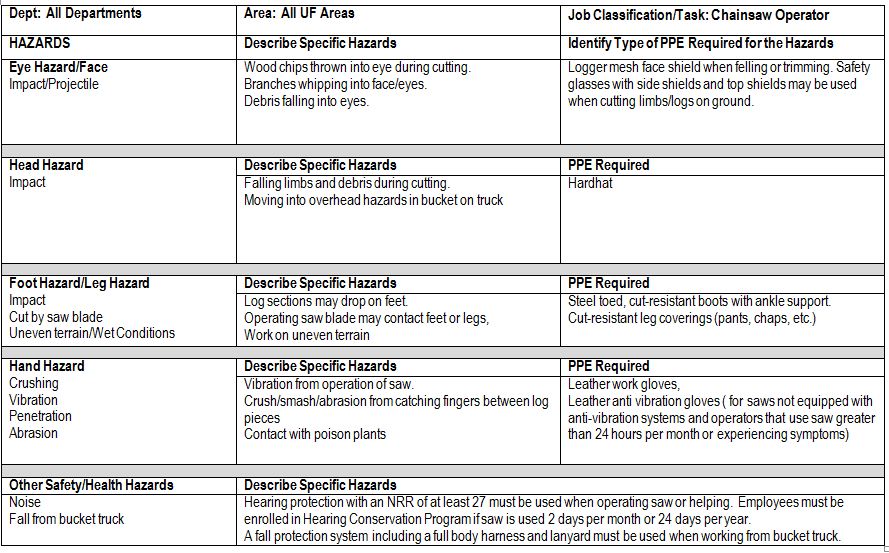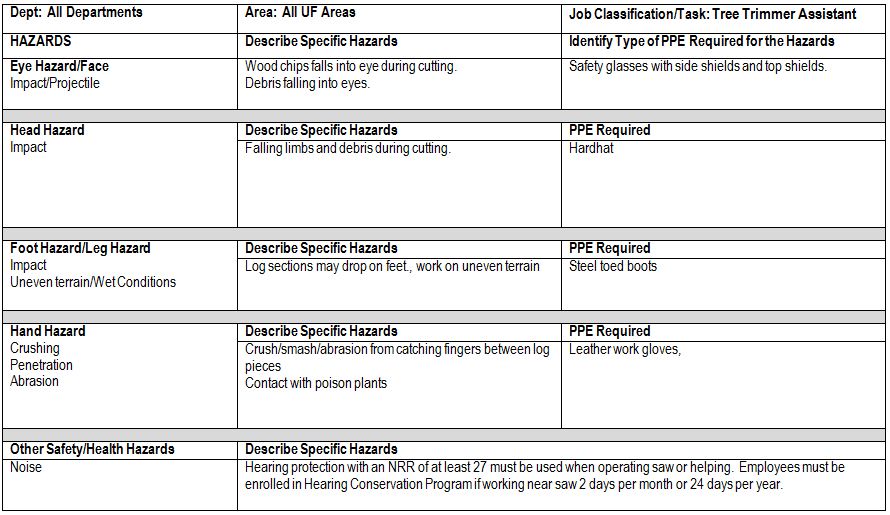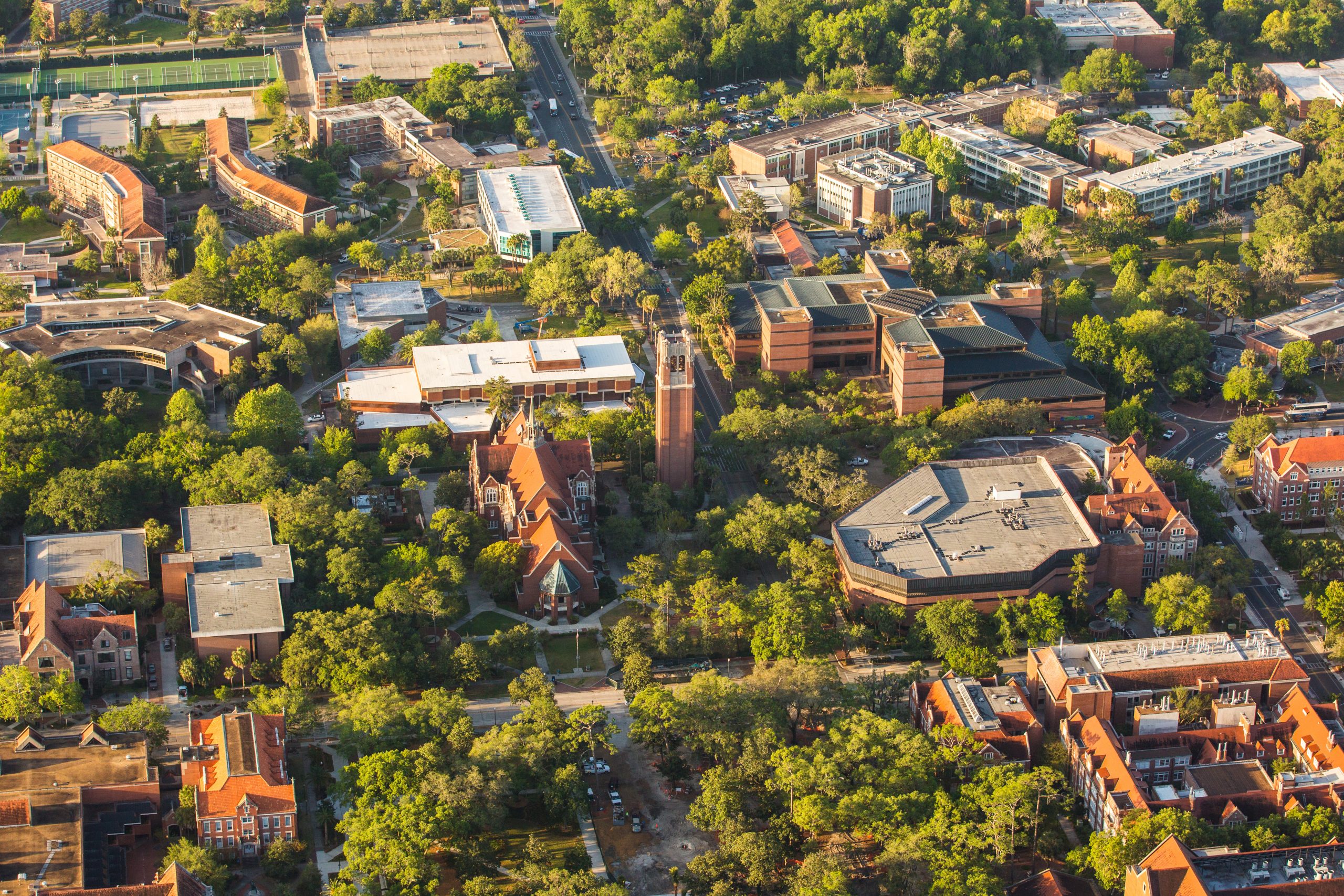
Chain Saw Safety Policy
OBJECTIVE
The objective of this policy is to reduce the risk of injury or fatality from use of chain saws for felling, cutting or trimming trees or wood by UF employees, students, volunteers and contractors under direct UF.
POLICY
This policy sets forth the requirements for work with chain saws by University of Florida personnel.
AUTHORITY
By authority delegated from the University President, the Vice-President for Business Affairs is responsible for the safety of all University facilities. Under this authority, policies are developed to provide a safe teaching, research, service, housing and recreational environmental.
RESPONSIBILITIES
Conducting hazard assessments and developing site safety plans for particular operations.
Supplying the necessary safety equipment that is maintained and meets current standards.
Ensuring the employees are trained on the policy and procedures included in this section.
Assuring that safe work practices are utilized and prohibit the use of poor of forbidden practices.
PROCEDURES
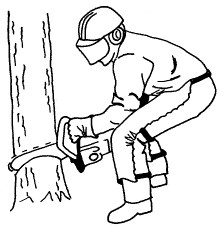 Chain saws are among the most hazardous power tools used. The unguarded blade, difficult terrain upon which one must often work and stresses applied to the materials to be cut creates high potential hazard. The use of proper operating procedures, personal protective equipment, safeguards on saws and proper work planning and execution can greatly reduce these potential hazards. Note: safe use of a chain saw requires an alert operator. Do not operate a chain saw if feeling fatigued or are taking prescription medication or non-prescription drugs that cause drowsiness or may otherwise impair the ability to function.
Chain saws are among the most hazardous power tools used. The unguarded blade, difficult terrain upon which one must often work and stresses applied to the materials to be cut creates high potential hazard. The use of proper operating procedures, personal protective equipment, safeguards on saws and proper work planning and execution can greatly reduce these potential hazards. Note: safe use of a chain saw requires an alert operator. Do not operate a chain saw if feeling fatigued or are taking prescription medication or non-prescription drugs that cause drowsiness or may otherwise impair the ability to function.- All chains saws used by University of Florida employees or students must be equipped with the following safety components:
- Chain catcher to prevent a broken or dislodged chain from striking the operator
- Throttle/Throttle interlock which will stop the chain when pressure on the throttle is released
- Muffler to reduce engine noise
- Hand guard minimizes chain saw kickback for saws placed into service before February 9, 1995 OR
- Chain brake lever to stop the chain if disengaged, for saws placed into service after February 9, 1995
- An Anti-vibration handle system is recommended to limit ergonomic stress to the operator’s hands and fingers.
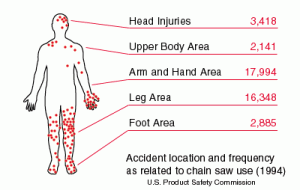 Head Protection: Hardhats must be worn when overhead hazards are present. On-ground helpers must wear hard hats whenever overhead work is conducted. Chain saw operators should wear hardhats during felling operations or when working from a bucket truck. The hard hats must comply with ANSI standards (Subpart I, ANSI Z89.1-1986).
Head Protection: Hardhats must be worn when overhead hazards are present. On-ground helpers must wear hard hats whenever overhead work is conducted. Chain saw operators should wear hardhats during felling operations or when working from a bucket truck. The hard hats must comply with ANSI standards (Subpart I, ANSI Z89.1-1986).
Eye and Face Protection: Logger-type mesh screens provide adequate protection for chain-saw operation. Mesh screens provide adequate protection to keep small limbs, branches, and saplings from poking the employee’s eye or cutting the employee’s face. Polycarbonate face shields provide adequate protection but have the disadvantage of fogging and becoming scratched.
Leg Protection: Each employee who operates a chain saw must wear leg protection made of cut-resistant material (e.g. ballistic nylon, polyester, Kevlar, etc.) The leg protection must extend from the upper thigh down to the boot top and adequately cover the leg (e.g. chaps, logger pants). Underwriters Laboratories (UL) labels leg protection which meets cut resistance requirements. (ASTM F1414-92a)
Foot Protection: Each employee involved in chain saw operations as an operator or a helper must wear heavy-duty steel-toe boots (ANSI Z 41-1991). These should be waterproof or water repellant and cover and provide support to the ankle. In addition, the chain saw operator must wear boots made with cut-resistant material that will protect against contact with a
running chain saw.
Underwriters Laboratories (UL) tests and labels foot protection that meets cut resistance requirements. (ASTM F1818-97) Material is considered “chain-saw cut-resistant” if it provides enough resistance to give the employee time to react before the chain saw cuts through the boot material or jams the flywheel and chains, thereby causing the saw to stop.
The chain-saw cut-resistant foot protection requirement applies to all employees who operate a chain saw regardless of the frequency of chain saw usage.
Properly sharpened teeth will cut quickly, smoothly and more safely. Wear leather gloves when sharpening the saw teeth. The saw teeth can easily inflict injury. File or grind according to instructions for best performance.
Check the chain tension and lubrication system for proper function. Proper chain tension helps to ensure long chain life and safer cutting. A chain that is too loose may derail and whip dangerously. A chain that is too tight will bind and wear prematurely. All chains stretch with use and frequently need checking and readjusting. Good lubrication helps prolong chain life and maintain tension adjustment. Check the oil often and refill according to instructions. Use the bar oil recommended by the manufacturer.
Follow the manufacturer’s instructions in the operator’s manual when making adjustments to the chain or engine.
Fueling: Fuel saw outdoors only. Always shut off engine and allow it to cool before fueling. Fuel the saw at least 10 feet from sources of ignition on bare earth if possible. Wipe up any spilled fuel and check for leaks especially around the cap. The chain saw must be started at least 10 feet from the fueling area. Chainsaw fuel must be stored in a 3 gallon or smaller approved (FM or UL) safety can.
Transporting Saw: The chain saw should be transported in a level position with the gas cap up, the bar behind you and the muffler on the side away from you. Carrying the saw with the engine running is dangerous and should be avoided. The saw should never be carried more than 50 feet with the engine running unless the chain brake is engaged. Shut off or engage the chain brake whenever the saw is carried on hazardous terrain
Always turn off the saw before putting it down.
Do not carry the saw in the passenger area of a vehicle. The saw should be transported in a case but if one is not available then keep the bar in a chain guard.
Starting Saw
Never “Drop Start” a Chain Saw! This is a dangerous practice and specifically prohibited by OSHA. Always start it on the ground or on a stable surface.
There is one acceptable method for starting a chain saw on the ground. Review operator’s manual for specific instructions for the equipment used.
Ground Start: Engage/lock the chain brake. Place the saw on the ground where good balance and secure footing can be maintained.Make sure the chain is off the ground and not touching5 anything. Grip the front handlebar firmly and press down. If the saw has a rear handle that is level with the ground, place toe of foot into the handle and place weight on foot. Turn the ignition on. Pull out the starter rope until resistance is felt then give a brisk, strong pull.
Determine the fall direction. Consider:
- rot or defect in the tree
- tree lean
- wind – will it have an effect on how and where the tree will fall?
- crown shape and limb weight
- surrounding terrain
- other trees – a very dangerous hazard is made when the cut tree entangles with another and does not fall completely
Identify all electrical lines in area. If an electric power line is in the vicinity of the tree, don’t attempt to work on the tree unless you are absolutely certain that it will not interfere with the electric line. If the tree must be removed and you suspect there will be a problem, call the power supplier, they have the expertise to do it safely.
Clear the area of people and vehicles. Set up barricades or safety monitors to keep people out of the danger zone. Generally, employees must not approach any closer than 2 tree-lengths of the trees being cut or under the branch canopy of trees being trimmed until the chain saw operator has acknowledged that it is safe to do so. Trees must be trimmed and felled in a manner that does not create a hazard to employees (i.e. work areas must be assigned so that trees cannot fall into adjacent occupied areas).
Plan a safe, unobstructed path of retreat before making a cut. The path should be at approximately a 45-degree angle away from the line of fall. Remove branches and debris that might be trip or fall hazards when retreating from a falling tree.
Plan and make the cuts carefully. Cutting must be done uphill from or on the same level as previously felled trees. Always keep in mind where the chain will go if it breaks; never position yourself or other people in line with the chain.
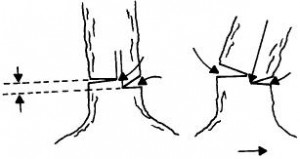 Smaller trees (up to a 5-inch diameter) may be cut clear through with one pass (ANSI Z133). Larger trees may require a series of cuts. Start with a 45-degree notch on the side that the tree will fall towards. Cut the bottom of the notch first, about one third of the way through the diameter. The second cut is made at a 45-degree angle that will meet the depth of the first cut. The felling cut should be made from the opposite side, about 2 inches higher than the floor of the notch. Do not cut all the way through but leave a hinge that will keep the tree from kicking back and upward as it falls. The hinge will be about 1/8 to 1/6 of the diameter where you are cutting but it may vary depending on when the tree starts to fall.
Smaller trees (up to a 5-inch diameter) may be cut clear through with one pass (ANSI Z133). Larger trees may require a series of cuts. Start with a 45-degree notch on the side that the tree will fall towards. Cut the bottom of the notch first, about one third of the way through the diameter. The second cut is made at a 45-degree angle that will meet the depth of the first cut. The felling cut should be made from the opposite side, about 2 inches higher than the floor of the notch. Do not cut all the way through but leave a hinge that will keep the tree from kicking back and upward as it falls. The hinge will be about 1/8 to 1/6 of the diameter where you are cutting but it may vary depending on when the tree starts to fall.
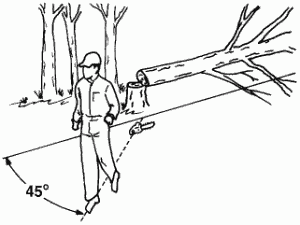 Retreat when the tree starts to fall. Shut off the chain saw, set it down safely (don’t throw it), and leave by the planned escape route. Do not return to the site until the tree is down and no longer moving. If the tree should roll, let it; one person cannot stop or control a moving tree.
Retreat when the tree starts to fall. Shut off the chain saw, set it down safely (don’t throw it), and leave by the planned escape route. Do not return to the site until the tree is down and no longer moving. If the tree should roll, let it; one person cannot stop or control a moving tree.
If a tree happens to be so well balanced that it does not fall after a felling cut has been made, two wedges can be used to start the fall and influence its direction. Always use two wedges and a sledge that has a face 1/3 larger than the face of the wedge.
Plastic wedges are safer than metal since they will not damage the saw teeth or chain. Always remove the chain saw when wedges are being driven into the cut. Strike the wedge carefully since a careless blow may cause the wedge to pop out of the cut and allow the tree to fall backward.
Never use an axe as the wedge or driver; the head of the axe may shatter and you could be injured by pieces of it. If cutting must be continued, insert the chain saw into the cut very carefully since the conditions are extremely dangerous.
Special precautions must be taken with “danger trees”. These include spring poles and hung-up trees or when any loose overhead debris is present such as limbs or tree tops that may fall at any time. Overhead debris is extremely dangerous and presents the crew with a continual source of danger.
Each danger tree must be felled or removed using mechanical or other techniques to minimize employee exposure before work is begun in the area of the danger tree. If the danger tree cannot be felled or removed, it must be marked and there shall be no work allowed within 2 tree-lengths of it, unless the supervisor demonstrates that a shorter distance will not create a hazard for an employee.
When cutting trees under stress, no employee other than the feller must be within 2 tree-lengths of the tree when the stress is released.
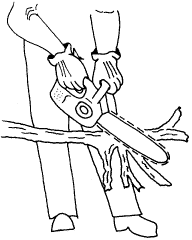 Be sure that the fallen tree is stable and will not move as you work. Examine the situation at every limb to be removed. Be certain that the limb will not bind against the saw. Cut on the opposite side of the tree trunk whenever possible, this keeps the trunk between you and the saw. Never make cuts with the saw between your legs, always cut with the saw to the outside of your legs. Don’t stand on a log and saw between your feet.
Be sure that the fallen tree is stable and will not move as you work. Examine the situation at every limb to be removed. Be certain that the limb will not bind against the saw. Cut on the opposite side of the tree trunk whenever possible, this keeps the trunk between you and the saw. Never make cuts with the saw between your legs, always cut with the saw to the outside of your legs. Don’t stand on a log and saw between your feet.
Never cut above shoulder height.
Never stand on the downhill side when removing limbs. Always keep in mind that the tree trunk may roll as limbs are removed. Watch for limbs that may spring out when they are cut due to the released tension. These limbs can cause injury.
Whenever possible, keep the tree limb or similar barrier between yourself and the saw blade.
Always stand to one side of the limb you are to cut, never straddle it.
Larger limbs may require more than one cut to be removed safely. Plan the cuts so that there will be no binding. Remember that stored energy can cause a cut to pinch the blade and immobilize your saw. Wedges can be used as previously mentioned. Always plan an escape route when removing large limbs since they may roll when they become free of the tree trunk.
When cutting large limbs and the trunk of the tree into convenient lengths be sure the trunk is supported along its entire length and will not roll. Block or wedge the trunk in place, if needed. Cut downward from the top of the trunk about one-third of the diameter and then roll it over to make final cuts.
Wedges can be used to keep the cut open if the log cannot be rolled over. They must be driven with care so they will not come into contact with the chain saw. Even though this should prevent pinching, always be alert to the situation.
Stand on uphill side when cutting because log may roll.
If the limb or tree trunk is supported by both ends as shown in Figure 7, cut downward one-third of the way and then finish by cutting upward from the underside to meet the first cut. Be careful to keep the saw out of the dirt, the teeth will throw debris and be dulled, and wear on the chain will be increased.
- When the nose of the blade strikes another object.
- Starting a bore cut improperly.
- When the blade nose or tip catches the bottom or side of a saw cut during reinsertion.
 The best defense against kickback is to keep the tip guard on the chain saw. However this does limit what you can do with the tool.
The best defense against kickback is to keep the tip guard on the chain saw. However this does limit what you can do with the tool.
Some kickback control can be maintained by keeping a firm hold on the saw and using a saw which has a chain-brake or kickback guard.
Be alert for blade-pinching situations.
Cut branches at the base of the blade; don’t saw with the tip of the blade. Use a high chain speed when reinserting the blade in a cut or removing it from a cut. Keep the saw teeth sharp so they will cut; dull teeth are more likely to cause a kickback.
Always cut below shoulder height, otherwise the saw is difficult to control and is too close to your face.
Helpers should never work so close to the chainsaw operator that they may be struck by the saw if it kicks back, or by a limb or a tree segment, which may spring due to stress.
PPE Certification of Hazard Assessment Minimum Personal Protective Equipment for
Chainsaw Operators
PPE Certification of Hazard Assessment Minimum Personal Protective Equipment for
Tree Trimmer Assistant
Training
Training must be provided to all personnel assigned to use or work on a crew that uses chain saws.
The training shall include:
- Safe performance of work tasks
- Safe use, operation and maintenance of chain saws and other tools used
- Review of the manufacturer’s operating and maintenance instructions, warnings and precautions
- Recognition, prevention and control of other safety and health hazards that may be encountered during typical work tasks
- Review of the requirements of University of Florida’s policies pertaining to the required tasks
Each new employee and each employee who is required to be trained shall work under the close supervision of a designated person until the employee demonstrates to the supervisor the ability to safely perform their new duties independently.

